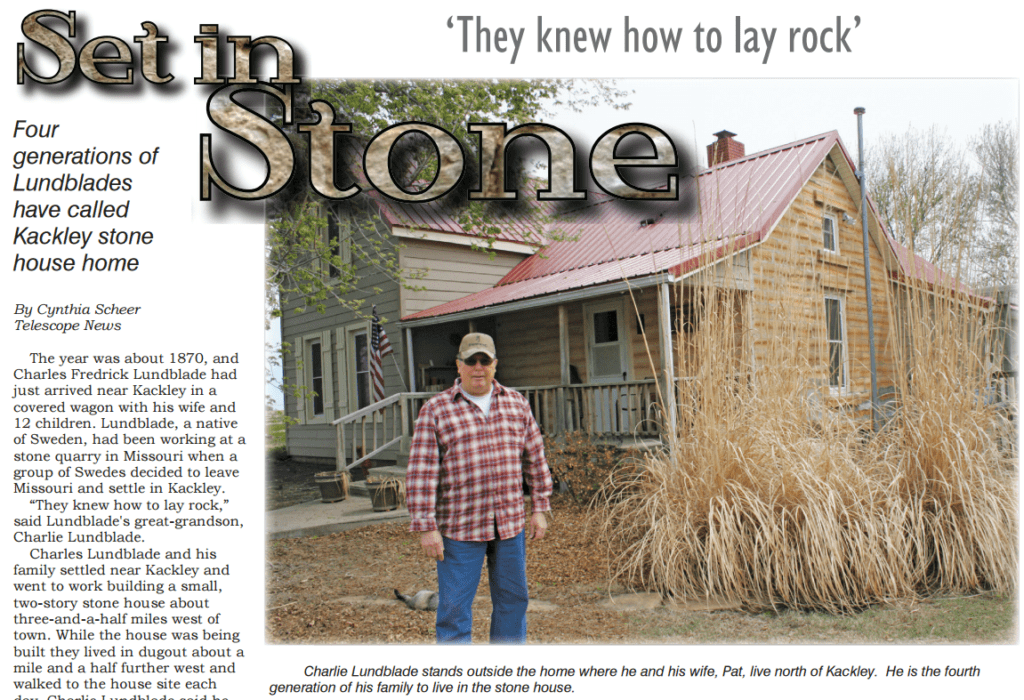
Four generations of Lundblades have called Kackley stone house home
By Cynthia Scheer – Telescope News
www.thebellevilletelescope.com
The year was about 1870, and Charles Fredrick Lundblade had just arrived near Kackley in a covered wagon with his wife and 12 children. Lundblade, a native of Sweden, had been working at a stone quarry in Missouri when a group of Swedes decided to leave Missouri and settle in Kackley.
“They knew how to lay rock,” said Lundblade’s great-grandson, Charlie Lundblade.
Charles Lundblade and his family settled near Kackley and went to work building a small, two-story stone house about three-and-a-half miles west of town. While the house was being built they lived in dugout about a mile and a half further west and walked to the house site each day. Charlie Lundblade said he thought the family lived in the dugout to be close to water until their home was fi nished and a well was put in.
A man from Kackley helped build a small stone retaininglike wall near the house, Charlie Lundblade said, and likely helped ‘They knew how to lay rock’ with the house, too. The man walked the three-and-a-half miles from town each day at 4 a.m. to help with the stone structures.
Rock used in the various stone structures came from the Lundblade’s pasture about a half mile south of the farmstead. Some of the rock from that pasture was also used to build nearby Ada Lutheran Church, which Charlie Lundblade said most of the people from the area began to build as soon as their homes were finished.
He said his great-grandparents likely built the stone chicken house, located about 50 yards west of the house, before they began work on the house. The chickens were a significant food source for the family, and a common lunch each day was eggs, Charlie Lundblade said. Once the stone house was finished the family moved the chickens into the main level of the house. Horses took over the original chicken house
The kitchen was located in the home’s basement. The family slept in the home’s small upstairs, which was only accessable by a ladder on the north side of the house. There was no heat source there in the winter, Charlie Lundblade said.
Some of the children may have slept in the chicken house or in the nearby wooden washhouse structure that had a screened in addition for summer sleeping.
The washhouse is still standing but will be torn down this summer, Charlie Lundblade said. The screened-in sleeping area has been gone for several years.
Four generations
Joseph Gideon Lundblade came to Kackley in his parents’ covered wagon when he was only three years old. He spent most of his life on the Lundblade farm and moved into the stone house with his wife, Florence, when his father, Charles Lundblade, died.
Joseph Lundblade’s son – and Charlie Lundblade’s father – James Eugene Lundblade, was born in 1917 and was the third generation to live in the Lundblade family’s stone house. He moved to Courtland in 1978 when Charlie Lundblade and his wife, Pat, moved into the home.
Charlie and Pat Lundblade were teachers in Lincoln before they moved to Republic County and took over the family’s stone house.
“We decided that either we needed to live here or sell it,” Charlie Lundblade said. “Once you sell something you spend the money and then you don’t have either [the money or the property.]”
The Lundblades said they don’t know if there will be a fifth generation of the family to live in the house. Their two grown sons have “good jobs” outside of Republic County, Charlie Lundblade said.
Remodeling stone
The stone house has seen a lot of renovation over its lifetime. Each generation to occupy the home has added on to the house, although Charlie Lundblade said his grandfather did most of the improvements. He built on two non-stone additions – a parlor to the north and a kitchen to the east. The thick doorways show off the stone home’s 18-inch thick walls, he said. His grandfather made cheese and beer in the stone cellar, which is located south of the house. Friends would sit and visit in the cool cellar during the summer as they sampled the beer and cheese. The cellar began to flood and collapse in the 1960s when the water table rose after the start of irrigation, he said.
Charlie and Pat Lundblade’s contribution to the home was to build a large bathroom and expand the kitchen.
The couple, who are retired teachers and rent out the farm ground that goes with the homestead, said they are proud to live in the stone house because of it’s history. They aren’t worrying about the home’s future.
“Our two sons will inherit it, and what they do with it is their problem,” 71-yearold Charlie Lundblade said.
Set in Stone is a periodic Telescope feature recording the history of limestone landmarks in Republic County

